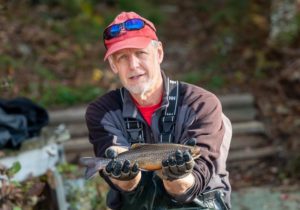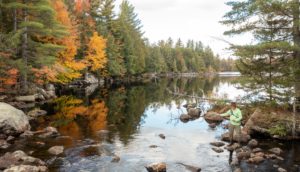Brook Trout Hook for Cornell Climate Change Research and Extension Outreach
Brook trout are so adapted to their native environment of the cool, clean, fresh waters of the Adirondacks, they’re also incredibly sensitive to change.
By CCE Staff

Cornell research support specialist Kurt Jirka holds a brook trout after taking its measurements at a lake near the Little Moose Field Station outside Old Forge, New York.
Image provided
In 1975, New York officially recognized the brook trout as the state fish. A favorite of anglers and a symbol of the pristine upstate wilderness, this species also contributes to New York state’s annual $2 billion freshwater fishing industry. Brook trout are native to the cool, clean, fresh waters of the Adirondacks. But because they’re so adapted to their environment, they’re also incredibly sensitive to change.
“Over the years, brook trout populations have faced declines due to the introduction of non-native fish species as well as acid rain,” said Cornell Cooperative Extension (CCE) Assistant Director Keith Tidball, who is also a senior extension associate in the Department of Natural Resources and the Environment at Cornell. “A new threat is the gradual warming of waters that brook trout call home, and cold-water fish do not thrive in warm water.”
The Department of Environmental Conservation has several restoration programs active to counteract the threats that face brook trout populations. From liming lakes to reduce acidity levels, to eradicating competitive non-native fish, the DEC has been working to restock waterways with native heritage strain brook trout and monitor populations.
“The state programs remain effective,” Tidball said, “but there are many ways in which the general public who are passionate about brook trout can contribute to these protection and conservation efforts.” With the help of CCE Innovation Smith-Lever Federal Formula Funds, Tidball and colleagues built upon this passion for brook trout and forged a campus-to-community connection with Adirondack partners.

Cornell Cooperative Extension Assistant Director Keith Tidball, also a senior extension associate in the Department of Natural Resources and the Environment, fishes for brook trout on Sagamore Lake near Raquette Lake, New York.
Image provided
Since conversations about climate change can be politically charged, CCE and Cornell faculty from the Adirondack Fisheries Research Program, as well as stakeholders such as Trout Unlimited, Trout Power, Great Camp Sagamore and others, are working together to leverage public interest in cherished flora and fauna – like the brook trout – to educate New York citizens about climate change and the threats it poses for fisheries and forests.
“It is important to shape the climate change narrative to focus on relevancy, cause and effect, and mitigation solutions,” says Jamila Page, senior issue leader at CCE Hamilton County. Page, along with CCE Herkimer County Executive Director Garet Livermore, has been working on outreach events in the region to raise awareness of climate change impacts on cold-water fish populations.
Initially, efforts focused on events related to the angling community at venues like the WILD Center and Adirondack Experience. In 2022, CCE will shift efforts toward more general outreach.
“We had really good experiences at the Old Forge Farmers Market and other places where locals and tourists gather,” said Livermore. “It turns out that the message of the survival of heritage strains of brook trout and preserving them for the future is of great interest to a wide cross-section of the public.”
This article originally appeared on CALS News.

